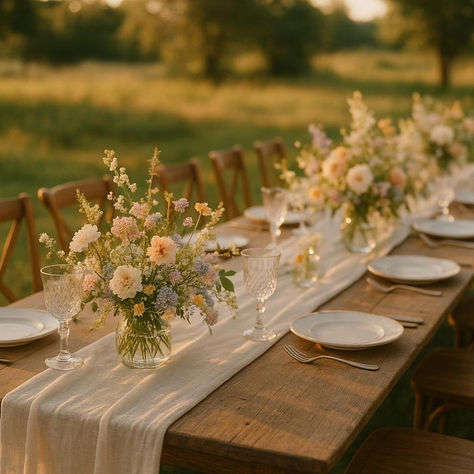
Ultimate Guide to Indoor and Outdoor Event Layouts
- Colin

- Mar 18
- 5 min read
Updated: Mar 20
Key Takeaways:
- Indoor Layouts: Controlled climate, fixed boundaries, focus on lighting, power outlets, and ceiling height.
- Outdoor Layouts: Flexible spaces, natural features, weather backup plans, and terrain adjustments.
- Guest Flow: Clear entry/exit points, accessible service areas, and logical activity zones.
- Comfort Tips: Provide shading, climate control, and quiet zones for relaxation.
Quick Comparison:
Aspect | Indoor Spaces | Outdoor Spaces |
Weather Impact | Controlled climate | Requires backup weather plans |
Lighting | Adjustable | Relies on daylight availability |
Flexibility | Fixed boundaries | More adaptable boundaries |
Surface Type | Uniform flooring | May need terrain adjustments |
For detailed planning tips, layout strategies, and examples like the Alamo Wedding Venue, dive into the full guide.
Wedding Layouts: Essential Guide to Ceremony Floor Plans and Space Design
Venue Space Analysis
When planning an event, understanding and optimizing venue spaces is key to ensuring functionality and enhancing the guest experience.
Indoor Space Requirements
When assessing indoor spaces, focus on these critical elements:
- Usable Square Footage: Exclude fixed elements like columns or built-ins to get an accurate measure.
- Ceiling Height: Important for lighting, decor, and overall ambiance.
- Power Outlets: Note their locations to plan for equipment and vendor needs.
- HVAC System: Check capacity and thermostat placement to maintain comfort.
- Service Entrances and Elevators: Ensure dimensions accommodate vendor equipment.
- Building Codes: Confirm occupancy limits and compliance with local regulations.
Outdoor Space Factors
Outdoor areas can significantly influence your layout. Pay attention to the following:
Factor | Consideration | Impact on Layout |
Ground Type | Surface evenness and material | Impacts the stability of setups |
Natural Features | Trees, gardens, water features | Shapes guest flow and focal points |
Sun Position | Daylight patterns | Affects seating and shade needs |
Weather Protection | Wind exposure, drainage | Guides structure placement |
Utilities | Power and water access | Determines vendor locations |
Spotlight: Alamo Wedding Venue & Events Center
The Alamo Wedding Venue & Events Center is an excellent example of thoughtful space planning. It offers a seamless blend of functionality and aesthetic appeal through well-defined zones:
- Courtyard Space: A limestone courtyard that serves as both a ceremony and reception area.
- Pool Area: Acts as a natural transition between indoor and outdoor spaces.
- Guest Accommodations: Includes three casitas and a main house, providing privacy and convenience for up to 18 guests.
- Natural Elements: Mature oak trees add both shade and charm to the setting.
- Lighting Design: Evening lighting highlights the venue's limestone features and creates distinct activity zones.
This venue caters to a wide range of events, from intimate elopements starting at $2,000 to grand celebrations with full venue access. It’s a great example of how thoughtful space analysis can result in elegant and functional event layouts.
Layout Planning Steps
Guest Movement Patterns
Ensuring smooth guest flow is a key factor in a successful event. Focus on these important zones:
- Entry and Exit Points: Place registration or welcome areas in spacious locations to handle guest lines efficiently.
- Service Areas: Position food stations, bars, and restrooms in accessible spots without creating crowding.
- Transition Spaces: Provide enough room between main activity zones to allow guests to move naturally.
- Emergency Routes: Make sure all emergency exits are clear and easy to access.
To avoid bottlenecks, place high-traffic spots like bars and buffets near walls or corners and create multiple pathways to key destinations. These flow strategies will help you plan the best layout for activity areas.
Activity Area Setup
- Dining Areas: Arrange seating to encourage conversation while maintaining enough space between tables.
- Dancing Areas: Set aside an open area that invites movement and socializing.
- Cocktail Areas: Place these close to service points but separate from dining zones to keep traffic manageable.
- Quiet Zones: Allocate calm spaces away from the louder, busier sections for guests who need a break.
Organizing activity zones in a logical sequence can naturally guide guest movement throughout the event.
Design and Function Balance
1. Lighting DesignUse lighting to highlight key areas while maintaining a safe, ambient glow throughout the venue.
2. Decor PlacementPosition decor in ways that enhance the space without disrupting flow. For example, keep table centerpieces low enough to avoid blocking views, and hang decorations in a way that preserves floor space.
3. Flexible SpacesPlan for areas that can serve multiple purposes. For instance, a ceremony space can later become a dance floor, or a cocktail area can double as a dessert station.
Indoor and Outdoor Setup Guide
Indoor Space Setup
When arranging an indoor space, make the most of natural features while ensuring good lighting and sound quality. Pay attention to windows, columns, and built-in lighting to create distinct zones and maintain smooth traffic flow. For lighting, combine ambient, accent, and task lighting to highlight key areas. Don't forget to keep emergency exit signs clearly visible for safety.
Outdoor Space Setup
Outdoor spaces come with unique challenges and opportunities. Blend the setup with the natural environment and plan for changing weather conditions. For example, at the Alamo Wedding Venue & Events Center, the stunning Texas Hill Country views and natural limestone add a special touch to events. Always prepare for bad weather by having a nearby indoor or sheltered area ready to keep guests comfortable.
Guest Comfort Planning
Comfort Elements
Creating a comfortable atmosphere starts with thoughtful seating and climate control. Place seating in naturally shaded areas or use shade sails that blend with the venue’s design. For example, the limestone features at the Alamo Wedding Venue & Events Center help keep temperatures cooler in the Texas heat. Use portable fans or heaters to adjust temperatures as needed, and ensure indoor spaces are kept at a stable temperature that matches the activity level.
Once these basics are covered, the next step is to design spaces that encourage guest interaction.
Activity Areas
Set up distinct social zones to promote natural guest flow and engagement. Arrange entertainment areas to reduce crowding, and use buffer zones to separate lively spaces from quieter ones. This setup caters to different guest preferences while maintaining easy movement throughout the venue.
In addition to comfort and well-planned activity zones, clear navigation ensures smooth transitions for guests.
Clear Directions
Guide guests effortlessly with well-placed, illuminated signs and subtle solar path lights. Use natural barriers or decorative elements to create intuitive pathways. To encourage movement between indoor and outdoor spaces, position complementary activities near each other. You can also provide elegant event maps at key locations or include them in guest materials, helping attendees explore and enjoy all areas of the venue.
Conclusion
Main Points
Creating effective event layouts is about finding the right balance between practicality and style. A good layout ensures smooth guest movement, comfort, and makes the most of the venue’s natural features.
For indoor venues, focus on defining specific zones while keeping pathways open for easy navigation. Comfortable temperatures and proper lighting play a big role in making the space welcoming. In outdoor venues, using natural elements like shade and existing architecture can elevate the design.
For example, Alamo Wedding Venue’s Texas limestone highlights how natural materials can shape a venue’s character. Its courtyard design shows how different areas can connect seamlessly, blending natural beauty with smart planning.
Planning for Changes
Event layouts should be ready to handle unexpected situations. A well-thought-out design allows for quick adjustments. Here are some areas to prepare for:
- Weather changes: Have an indoor backup plan for outdoor events and clear strategies for moving guests and activities if needed.
- Seating flexibility: Use layouts that can be easily adjusted for changes in guest numbers.
- Portable lighting: Include lighting options that can shift the mood or improve visibility as needed.
- Extra space: Keep some buffer zones in key areas to handle last-minute changes or additions.
The key to a successful event layout is its ability to stay functional and stylish, even when plans need to shift.















Logo fonts are built with branding in mind, and they really make a difference in design. I used the best logos fonts for a small business logo, and the result was professional and unique without needing too much tweaking. These fonts are crafted to stand out and leave a lasting impression. If you’re working on brand identity or want a font that feels distinctive, logo fonts are worth trying.